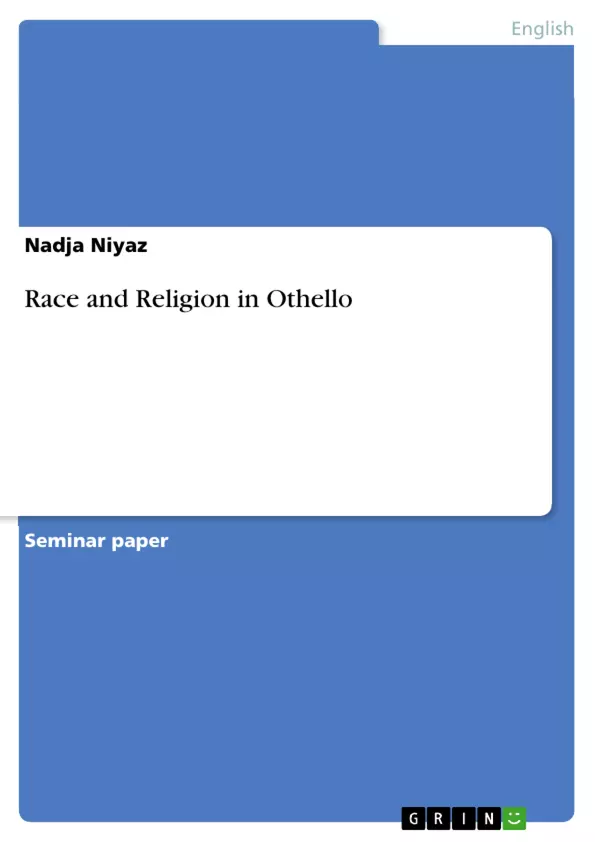This paper is structured into two parts – in the first part about race I first want to talk about some theories about Othello’s race, Elizabethan stereotypes about Moors and what might have been reasons for making Othello, the Moor of Venice. In the second part I am going to focus on the part religion plays in Othello, the opposition of Christianity against Islam, the influence religion, the bible and the other character’s religious affiliations play in Othello and of course Othello’s own religious denomination.
Table of Contents
- Introduction
- Race and the Moor in Elizabethan England
- Definition of race and the term 'Moor'
- Elizabethan Stereotypes - Images of the foreigner
- How well-known was "the Moor" in Shakespeare's time?
- Historical context - Why is Othello a "Moor"?
- Religion and biblical allusions in Othello
- Islam vs. Christianity
- Desdemona
- Iago
- Othello
- Conclusion
Objectives and Key Themes
This paper aims to explore the multifaceted representation of race and religion in Shakespeare's Othello, specifically examining how these elements contribute to Othello's social exclusion and the play's dramatic conflict. It analyzes the ambiguous nature of the term "Moor" in Elizabethan England and how Elizabethan stereotypes of foreigners influenced the characterization of Othello. The role of religious conflict between Islam and Christianity, and its impact on the characters' actions and motivations, is also investigated.
- The ambiguous and fluid definition of "race" in Elizabethan England and its application to the character of Othello.
- The impact of Elizabethan stereotypes of Moors and foreigners on Othello's portrayal and his social standing.
- The religious dimension of the play, focusing on the conflict between Islam and Christianity and its influence on character relationships.
- The interplay between Othello's racial and religious identity and his social marginalization within Venetian society.
- The exploration of how Othello's outsider status contributes to the play's central conflicts and tragic events.
Chapter Summaries
Introduction: This chapter introduces the central theme of Othello's paradoxical position as a highly regarded military general yet simultaneously an outsider due to his race and/or religion. It highlights the enduring scholarly debate surrounding Othello's skin color, religious affiliation, and social exclusion, emphasizing the evolving interpretations of the play across different historical and cultural contexts. The chapter establishes the two-part structure of the paper: the first focusing on race and the second on religion's role in the play.
Race and the Moor in Elizabethan England: This chapter delves into the complexities of defining "race" in Elizabethan England. It explains that the contemporary understanding of race differs significantly from the Elizabethan one, where the term often referred to national or linguistic groups rather than strictly biological classifications. The chapter explores the historical context of the word "Moor," highlighting its elasticity in encompassing various ethnicities and religious affiliations (Muslim or Christian, light or dark-skinned). It also examines prevalent Elizabethan stereotypes of foreigners, particularly the association of black men with hyper-sexuality and the anxieties surrounding racial and sexual difference. The ambiguity of "Moor" is emphasized, acknowledging the potential for Othello to be light-skinned Arab or Spaniard, rather than a dark-skinned African, and the consequent impact on how he was perceived within the context of Elizabethan society.
Frequently Asked Questions: A Comprehensive Language Preview of Othello
What is the main focus of this language preview?
This preview provides a structured overview of a paper analyzing the multifaceted representation of race and religion in Shakespeare's Othello. It examines how these elements contribute to Othello's social exclusion and the play's dramatic conflict. The preview includes the table of contents, objectives, key themes, chapter summaries, and keywords.
What topics are covered in the Table of Contents?
The table of contents includes: an Introduction; a section on Race and the Moor in Elizabethan England (including the definition of "Moor," Elizabethan stereotypes, Othello's historical context); a section on Religion and biblical allusions in Othello (including Islam vs. Christianity and analyses of Desdemona, Iago, and Othello); and a Conclusion.
What are the key objectives and themes of the paper?
The paper aims to explore the ambiguous nature of the term "Moor" in Elizabethan England and how Elizabethan stereotypes influenced Othello's characterization. It investigates the religious conflict between Islam and Christianity and its impact on the characters. Key themes include the fluid definition of "race" in Elizabethan England, the impact of stereotypes on Othello's portrayal, the religious dimension of the play, the interplay between Othello's racial and religious identity and his social marginalization, and how his outsider status contributes to the play's conflicts.
What does the chapter on "Race and the Moor in Elizabethan England" cover?
This chapter examines the complexities of defining "race" in Elizabethan England, explaining its difference from modern understandings. It explores the historical context of "Moor," highlighting its flexibility in encompassing various ethnicities and religious affiliations. The chapter analyzes prevalent Elizabethan stereotypes of foreigners and the ambiguity of "Moor," acknowledging the potential for Othello to be light-skinned, and the impact on his perception within Elizabethan society.
What does the chapter on "Religion and biblical allusions in Othello" explore?
This chapter delves into the religious conflict between Islam and Christianity in the play and its influence on the characters' actions and motivations. It examines the religious dimensions of the characters of Desdemona, Iago, and Othello themselves.
What is the overall approach of the paper?
The paper adopts a scholarly approach, analyzing the themes of race and religion in a structured and professional manner, drawing on historical and cultural contexts to interpret the play's complexities.
- Citation du texte
- Nadja Niyaz (Auteur), 2017, Race and Religion in Othello, Munich, GRIN Verlag, https://www.grin.com/document/369109



